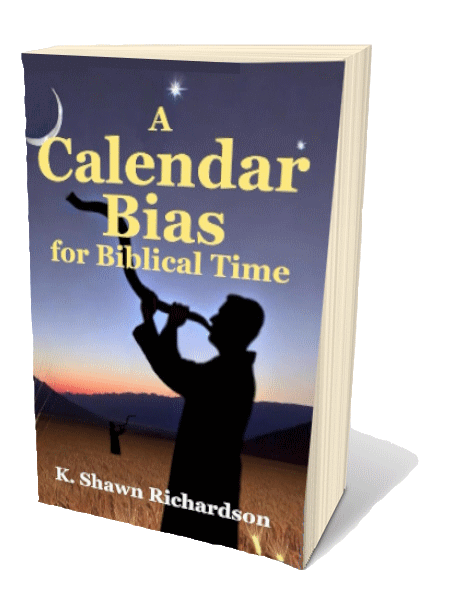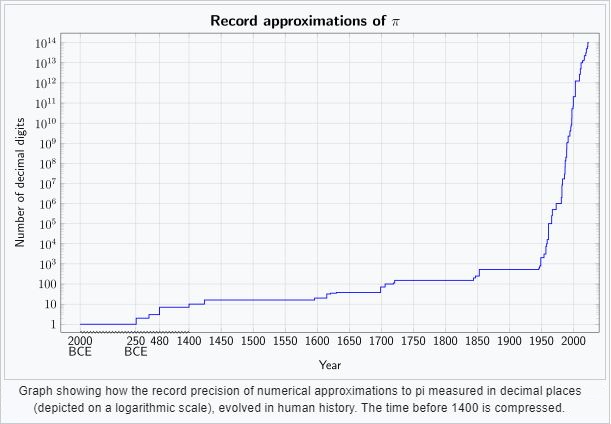A Calendar Bias for Biblical Time
(Revised 2015) By: Shawn Richardson
|
GO TO SECTION: Index | 1 | 2 | 3 | 4 | 5 | 6 | 7 | 8 | 9 | 10 | 11 | 12 | 13 | 14 | 15 | 16 ACCURACY |
Now Available!You are currently reading an earlier version of this research paper. Please consider purchasing the latest version in paperback or Kindle format below. Proceeds help support RenewedMoon.com, a website fostering communication among the body of believers by inviting community participation in submitting sightings and sharing updates from global and Israel-based perspectives. Through these efforts, the site promotes education on the observational calendar.: |
Section 10:ACCURACYSo how accurate are the computations of today's Hebrew calendar? The Hebrew calendar claims to be lunisolar, meaning it considers both the cycles of the sun and moon. However, this claim is not completely accurate due to additional non-Biblical rules and the fact it relies on averages rather than predicting the actual events. We will also see that even the calculated averages are not 100% accurate and are slowly drifting out of position over the centuries. Yet, supporters of the Hebrew calendar continue to endorse its accuracy. John Ogwyn of the Living Church of God, author of an article titled 'The Hebrew Calendar,' explains[16]: "...in antiquity, man had only two ways of knowing the time of the new moon. One was by physical sighting of the crescent; the other was by calculation based upon the average time between conjunctions. The Hebrew calendar uses 29 days, 12 hours and 793 parts (an hour contains 1,080 parts) as the duration of the average lunar month. This works out to 29.53059 days in decimal form. According to the 15th edition of Encyclopedia Britannica, modern astronomers using satellites and computers have come up with the figure 29.530589-one one-millionth of a day difference!" This indeed describes an amazing level of accuracy for determining the average lunar cycle using observation. However, it is the accumulation of that small amount of error, albiet small, that proves the establishment of today's Hebrew calendar was first implemented around the 9th or 10th century C.E. (depending on where it originated). This is achieved by taking the growing difference between these two calculations (the calendar's Molad calculation versus that of modern astronomers) and reverse-engineering when this difference did not exist. This debunks the assumption that the Molad average was divinely given by God at the time of Moses, or that it somehow proves its divinity through its amazing accuracy.
If you believe the Molad calculation was established during the time of Moses (or even during Yeshua's ministry), then a one-millionth of a day difference might seem miraculous. Comparing this to the historical progression of mathematical precision, such as the calculation of pi, we would observe that ancient mathematicians were only accurate to a single decimal position (one-tenth) until around 250 B.C.E. Archimedes then increased that accuracy to two decimal positions (one-hundredth) until Ptolemy improved to three positions (one-thousandths) in 150 C.E. Finally, it was the Chineese mathematician Zu Chongzhi that had the revolutionary discovery, increasing the accuracy to seven positions (one-ten millionths) in 480 C.E. Given this context, the Molad calculation's level of accuracy suggests its institution falls after this timeframe. By the 21st century, of course, through the advent of computers, we can now calculate pi to over 1014 (one hundred trillion) decimal positions. Surely, if God Himself had provided a miraculous calculation for the Molad, He could have been more accurate than one-millionth of a day. Furthermore, it does not explain why these computations for the Molad are applied to determine the moon's conjunction rather than the visible new moon crescent, or why Jerusalem and the noon hour are chosen as the line of final determination. It also does not explain why 12 out of 13 months within the Hebrew calendar system are not determined by this same 'micraculous' Molad calculation and instead are assigned a fixed number of days for each month based on postponement rules. Finally, John Ogwyn ignores the fact that the 19-year cycle of inserting an intercalary 13th month (leap month) is even less accurate than its lunar cycle counterpart, the Molad. Drifting Solar YearEdward Graham Richards, in his work "Mapping Time - The Calendar and its History,"[20] notes that the Hebrew calendar's average year exceeds the mean tropical year by 6 minutes and 40 seconds. This discrepancy leads to a cumulative drift of approximately one day every 216 years. Since the fourth century, this drift has accumulated to over seven and a half days in relation to the equinox. Consequently, the insertion of an intercalary leap month in certain years of the Hebrew calendar's 19-year cycle occurs a year earlier than the tropical year would necessitate. This misalignment increasingly causes the observed aviv barley to diverge from the calendar's predictions.
Over extended periods, this will result in the Passover holiday occurring later in the year, eventually transitioning from spring to summer. However, this shift is projected to take over a millennium to manifest fully. Rabbi Hillel II's introduction of the 19-year intercalary cycle, which determines the addition of a 13th month in years 3, 6, 8, 11, 14, 17, and 19, was originally intended to align Passover with the appropriate season. Despite this, the reliance on mathematical calculations over empirical observation of barley has led to growing inaccuracies. Scholars continue to explore alternatives to the current Hebrew calendar, seeking a more precise mathematical model. This includes Jewish scholars. Nonetheless, the inherent variability of the universe, including factors both known and potentially altered by divine intervention, precludes any formula from achieving absolute precision. Standardizing time into a calendar inevitably sacrifices some degree of accuracy. Ultimately, only a divine entity could devise or conform to a calendrical system that maintains exactitude over millennia or adjust celestial mechanics to align with mathematical averages. Further evidence that the celestial bodies set forth in Genesis were designated for timekeeping, not the mathematical constructs that have since been developed. The Jewish community acknowledges the limitations of the current calendar system and its gradual deviation from its original purpose. Despite this, they continue to use it, considering it the most effective method available, though there is a growing recognition that a revision may be necessary. The Wapedia Encyclopedia, in an article entitled "Rectifying the Hebrew Calendar,"[33] discusses the significance of precise timing in Jewish rituals and the potential need for a recalibrated system to address the slight but increasing discrepancies in the lunar cycle. The article raises pertinent religious inquiries regarding the practicalities of such a system's implementation and governance across the global Jewish diaspora. "Given the importance in Jewish ritual of establishing the accurate timing of monthly and annual times, some futurist writers and researchers have considered whether a 'corrected' system of establishing the Hebrew date is required, due to the small but accelerating changes in the actual lunar cycle interval. Further religious questions include how such a system might be implemented and administered throughout the diverse aspects of the world Jewish community. Historically, the fixed arithmetic Hebrew calendar was instituted by the authority of Hillel ben Yehudah, the President of the Sanhedrin, in the Hebrew year 4119. It is widely accepted that only an authority of comparable stature, such as a modern Sanhedrin, has the jurisdiction to modify or restore the observational Hebrew calendar. The article notes that while there is an understanding that observational methods were historically employed and might need to be reinstated, the authority to enact such a change is lacking. As adherents of Yeshua, the belief is that one need not await the Messiah or a High Priest to effect this change. Followers consider themselves both the temple and the body of Yeshua, the Church, as referenced in I Peter 2:5, and thus possess a foundational system capable of restoring the observational practices of antiquity, supported by biblical teachings. Nevertheless, it is observed that many church groups have opted to disregard this approach, aligning instead with the prevailing Jewish practice. Rood Ministries, a group dedicated to following the signs of Aviv barley, have taken it upon themselves to plant barley near Jerusalem (and other surrounding locations within Israel) annually to determine the appropriate month the barley is considered aviv. Here are their findings [14]: "...since our return to the land, observation of the barley crop has proven that the rabbinic cycle is often in error and now obsolete. Over the past decade, several Israelites have investigated the state of the barley crop at the time that the modern Jewish calendar declared the month of Aviv (Nissan) and discovered that the barley was not yet aviv." Waiting To Be FixedThe Wikia Encyclopedia acknowledges the diminishing accuracy of the Hebrew calendar and delineates the reasons for the absence of corrective measures. The 'Accuracy' section[20] articulates that any amendment to the 19-year cycle, which is integral to codified Jewish law, necessitates the assembly of a Sanhedrin. This event is traditionally linked to the advent of the Messiah, signifying the onset of the redemption era in Jewish eschatology. "As the 19 year cycle (and indeed all aspects of the calendar) is part of codified Jewish law, it would only be possible to amend it if a Sanhedrin could be convened. It is traditionally assumed that this will take place upon the coming of the Messiah, which will mark the beginning of the era of redemption according to Jewish belief. Theoretically, if Jewish law could be modified, one solution would be to replace the 19-year cycle with a 334-year cycle of 4131 lunations. This cycle has an error of only one day in about 11,500 years. However, this would be impossibly cumbersome in practice. Further, no such mathematically fixed rule could be valid in perpetuity, because the lengths of both the month and tropical year are slowly changing."
Presently, an entity professing to be the reconstituted Sanhedrin is advocating for the Third Temple's restoration in Jerusalem and a return to ancestral traditions. They recognize a significant deviation in the contemporary mathematical calendar, established in the 4th century, as detailed in their 'Fixing of the Calendar' article[7]. "In recent years, a situation has been created where more and more frequently the onset of spring does not coincide with {the} calendar currently in use. This means that the calendar is beginning to drift noticeably. Albeit, the rate of drift is very slow, much slower than other lunar calendars (such as the Islamic calendar). However, if continued unchecked, we will be celebrating Pesach in the summer, rather than the spring. Our current calendar will exceed halachically acceptable limits and we will be celebrating Biblically commanded holidays at times other than when Scripture requires them to be celebrated. One could argue that if a change is necessary in any event, it would be most correct according to Biblical and Jewish Law to once again use the system of witnesses. But it is certain that we will no{t} longer be permitted to use the mathematical calendar of Hillel II in the near future." They confirm that, if unaddressed, this drift will result in the observance of Pesach during summer rather than spring, contravening the halachic parameters and the Biblically mandated timings for holidays. They propose that a transition back to the witness-based system would align with Biblical and Jewish Law. However, they concede that the continued use of Hillel II's mathematical calendar will soon become untenable. This stance corroborates the necessity for imminent alterations to the current calendar to maintain its relevance for the Jewish community. And an observational method reliant on witnesses is suggested as a viable, scripturally compliant alternative allowed by Jewish law. |
|
GO TO SECTION: Index | 1 | 2 | 3 | 4 | 5 | 6 | 7 | 8 | 9 | 10 | 11 | 12 | 13 | 14 | 15 | 16 |
Revised paperback and Kindle edition available on Amazon





 Even Jews admit that their theoretical, mathematical solution to enhance precision would be deemed impractical due to its complexity and the gradual changes in the lengths of the lunar month and tropical year. Ultimately, it's the reestablishment of the Sanhedrin court, as explained by AllExperts Encyclopedia[
Even Jews admit that their theoretical, mathematical solution to enhance precision would be deemed impractical due to its complexity and the gradual changes in the lengths of the lunar month and tropical year. Ultimately, it's the reestablishment of the Sanhedrin court, as explained by AllExperts Encyclopedia[